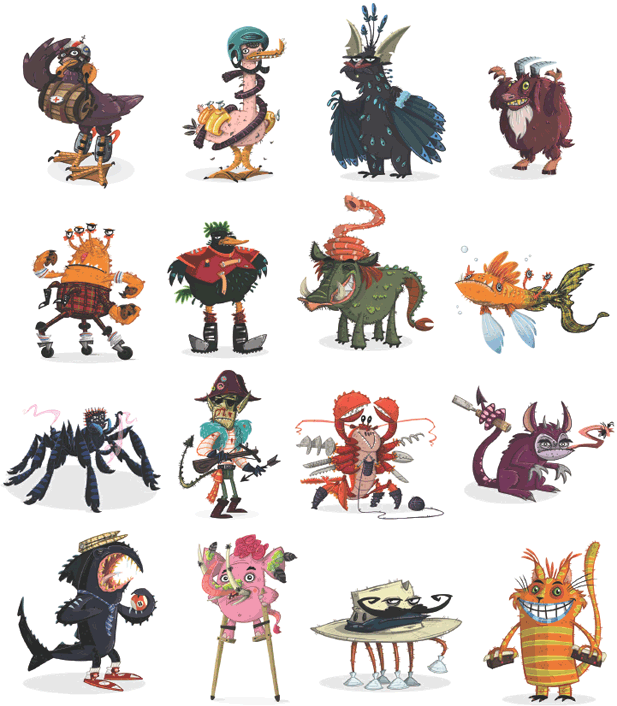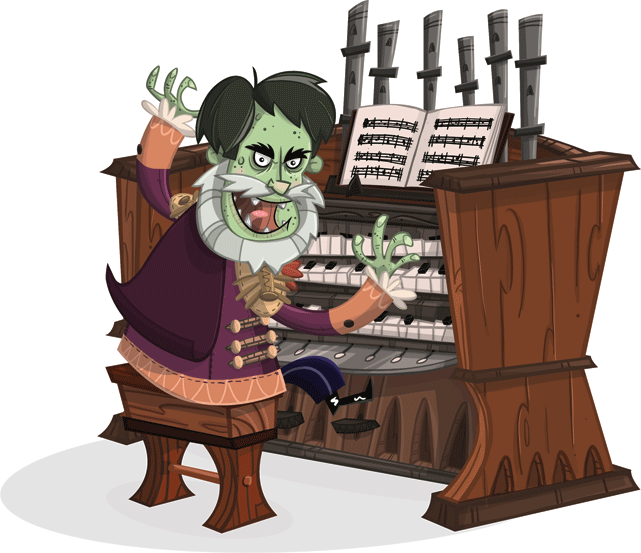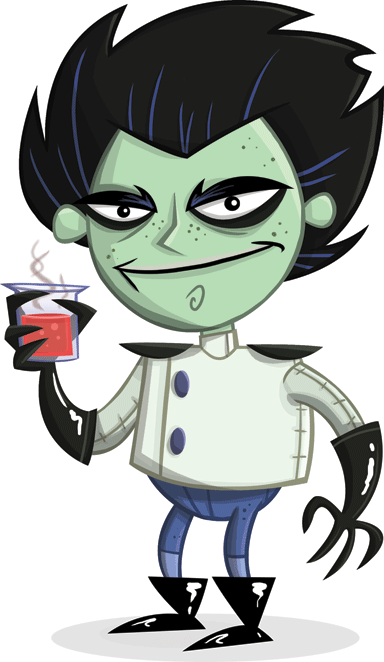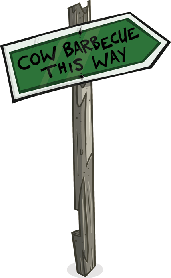

Not all monsters are the same. Some monsters are born that way; some choose to be monsters and others had no choice in the matter at all and were created in secret laboratories. But all in all, there are three main types of monster.
Monsters who were born a monster
Just as giraffes are born as giraffes and tigers are born tigers so these monsters are born to be monstrous. Gobblesocks were born to be gobblesocks—they like to gobble socks because that’s what gobblesocks do. Bucket bogles, say the scientists, are also born like that. They are bogles, and they live in buckets, because that’s what bucket bogles do.
Monsters who chose to be a monster
A few monsters started out as something else, but decided it would be much more fun to be a monster. Some of the copywrong pirates were born pirates, but most started out as something else and saw their way to more fun. Sensible cows used to be much larger, and chose to be smaller so they wouldn’t be milked or eaten. Motets only stopped looking like top hats when toppers went out of fashion.
Monsters made in a laboratory
Many of the world’s monsters were bred in laboratories; many by evil scientists. There was a family of evil monster-making scientists called the Blenkinsops.
The Blenkinsops and their monsters
The first of this family’s wicked line who matters here was the brilliant and famous Countess Agatha Blenkinsop, an English aristocrat of peccable breeding. She was far from couth, never kempt, and nothing made her as gruntled as suffering. The history books reveal that she was a famous axe murderer; having killed three completely harmless axes by feeding them to some of her savage toothy gum trees which she had imported from the state of Catatonia to her hideout in Rottingdean, in southern England.
Countess Agatha was typical in a family which had been showing signs of failure since the days of Sieur Guillaume de Blenkynsoppe, who invented a new form of naval warfare in 1087. Sieur Guillaume was a Norman noble who heard that the Romans and Greeks used to fit their ships with sharp iron points called rams, to sink other ships.
Now the Blenkinsop family have always been good on ideas, but bad on good ideas. They believed that being good on bad ideas was near enough. That was their problem. Sieur Guillaume decided that a battering ram, a super-sheep with 104 legs, would be even better for sinking other ships, and that two were better than one. He failed to understand that battering rams hate salt water and have bad tempers and tough feet.
Upset at getting a face full of water every 15 seconds, the battering rams kicked in the sides of the ship, broke loose and swam away as the ship sank, drowning all on board. One of the battering rams became a moat monster in later life, while the other one bought a small farm and went into business as a breeder and trainer of miniature trolls. Neither of them ever forgot or forgave the Blenkinsop family.
The next family member to appear in the records was Sir Roger de Blenkynsoppe, who invented an improved cannon in the days of King John, several hundred years before England had any gunpowder. The cannon sat, doing nothing and, in the end, Sir Roger threw it in a moat. An annoyed moat monster ate him.

Roger’s great-grandson, Sir Percy Blenkynsoppe, tried to fix this, soon after new cannon were made in England around 1327. Sadly, he misheard his grandfather’s account of Sir Roger’s problems, and invented gumpowder instead. This was mildly explosive, but Sir Percy foolishly tried chewing some, and historians believe he must have become very upset. A record from that time says he completely lost his head, whatever that means.
Sir Percy’s grandson, Sir Peregrine Blenkynsopp, was active in the 1370s, when he tried to introduce the cork battleship, but these blew away in a gale, carrying their inventor away as well. In the early 1500s, Sir Ferdinand de Vere Blenkinsopp invented the helmet-mounted blunderbuss. The first time Sir Ferdinand tried this weapon out, he flew backwards off his horse and into a moat, where a moat monster with a long-standing grudge against the family was waiting.
In 1588, Sir Francis Blenkinsopp had a marvellous idea for stopping Spanish cannonballs sinking English ships; to glue a thick layer of wool on the outside of the hull. As there was a shortage of wool at the time, Sir Francis glued live sheep to his vessel, the Golden Ewe, and then attempted to mount a surprise attack on the Spaniards, who managed, somehow, to hear him coming. It was one of the few victories the Spanish had that year. The sheep fell into the sea and survived, and were used by the Spaniards to breed their famous marino sheep.
In the 1660s, Sir William Blenkinsopp invented the shoe gun, which was fired by stamping the foot. Regrettably, he then took part in a spirited courtly dance, with a lot of jumping, and spent the rest of his life (about two weeks—justice was swift then) in gaol for endangering the king’s life.
In 1720, Sir William’s grandson, Sir Daniel Blenkinsop, invented the parachute. As aircraft and balloons had not been invented, he went aloft in a South Sea Bubble, and when that burst, he fell. He survived, landing in a moat, but another moat monster with a long memory was waiting.
In 1788, another of Agatha’s ancestors, Arthur Blenkinsop, invented the bicycle pump. As this was half a century before bicycles and a century before bicycles had pump-up tyres, it was a failure, but it was a failure in the family’s grand tradition. So was Arthur, who tried to use the bicycle pumps to power a compressed-air engine on a small boat which became lost in fog and was never seen again. In other words, Countess Agatha was just following a long history of bad choices. But unlike her ancestors, she was also evil. She also knew that many of her family had died at the hands, well, the teeth really, of monsters, so she devoted her life to breeding evil monsters who would do her bidding.

Agatha was eventually imprisoned for life but before she was taken away, the brilliant Countess gave birth to a son, Count Henry and, luckily (for him), the authorities never found out about the birth until too late. Her son and grandson carried on Agatha’s work, but, like their ancestors, they were incredibly unfortunate. Count Henry was brought up by a team of special miniature trolls who had been bred by Countess Agatha (but guess where she bought the original pair!). These trolls captured small furry things at night and brought them back for Henry to eat, live. They also taught Henry things, most of them not very nice. They even tried to teach him the art of house breaking, but Henry was quite small, and even when he climbed up on a roof and jumped up and down, the house never broke.
When he was young, Henry lurked in a cellar, deep beneath the ground in a ruined abbey (it was fine when he moved in, but the miniature trolls used to play on the roof). Every night Henry played the organ. Some say it was a mouse organ, and that he would bite the tails of tuned mice to make them squeak. But Henry liked mice, so this is unlikely. We know that the mice persuaded him to base a number of his early monsters on cakes, so that the mice could eat the crumbs.
When Henry was young, the only time he saw a human was in a video series made by Countess Agatha explaining how to operate on animals and change them into monsters. He began as a strange little boy; he ended up a strange huge man, riding around the moors on moonlit nights on the backs of four snow-white trolls, searching for new victims that he could use for monster parts.

Count Henry’s first experiment was an upside-down dragon, based on an upside-down cake. It was never able to fly. Henry’s next experiment, to cross a kangaroo with a mastodon, ended when the kangarastodon destroyed most of the surviving bits of his abbey before it jumped on the upside-down dragon and ate it, slipped between two slices of bread.
Once, when an old fortune teller asked him to cross her palm with silver, he agreed, but Count Henry was extremely cruel: he failed to mention that Silver was his horse. That night, the fortune teller sneaked into the Count’s underground laboratory and, with her one good unsquashed hand, changed the labels on many of the specimens and chemicals. The result was disaster.
When Henry tried to cross a cat with a budgerigar to get a purring pet that would live on seed, he got a monster that hunted and ate itself.
When he tried to cross a chicken with a spider to get a chicken that produced eight drumsticks, he ended up with a monster with a venomous peck that ran too fast to be caught.
When he tried to cross a camel with a spider to get a beast that had camel hair as fine as spider silk, he made a huge monster with a hump, bad breath and the ability to kill with its poisonous spit.
When he tried to cross a mouse with a death-watch beetle to get a beetle that would make holes in cheese, he ended up with a boring rodent that went around head-butting post impressionists in the ankles. They did not think that was amusing.
When he tried to cross a river with a barbed wire canoe, he sank, went over the Reichenbach Falls, and was never seen again. All the monsters cheered, especially the moat monsters. That may have been naughty, but could you blame them? Still, even if the Blenkinsops usually went wrong, enough of their creations survived—a lot of the monster plagues we suffer today are the result of their failed experiments. Unfortunately, the family members were all incredibly boring, so not a lot was written about them. On top of that, the family’s records were destroyed in the fire that followed Junior’s attempt at filling barrels with nitro-glycerine soup to use as a bait for moat monsters.
Now the Blenkinsop family, against the odds, also survived for some time. Count Henry had been married and had a son—Count Henry Blenkinsop Junior—who tried to carry on his father’s work. But, where the father was brilliant, unlucky and unspeakably evil at everything, Junior was clumsy, uneducated and unspeakably bad.
He was bad at everything he tried including cooking, but even his fiercest critics agreed that at the end of his career, he turned out to be very good at flying. He flew out through the roof one day and nobody ever saw him again, and that was the end of the Blenkinsops.
Since the day Junior blew himself up, no new monsters have been seen, which is probably just as well, but there are lots of old monsters. The good news is that all the monsters we see today are sort of harmless, scared of humans, or both. They are handy to have around and all the better for us to play with, so long as we all understand each other.
Where monsters live
Every monster has a favourite place to be (even though they can turn up anywhere). Monsters are very nervous and easily frightened, so they usually hide in cupboards or shoes, or under buckets or beds. In fact, if you want to attract a lot of monsters, put a bucket, upside down, in a cupboard or under your bed and listen carefully. When the cries of ‘I was here first!’ get very loud, you can put your head under the bed or in the cupboard, and with one ‘BOO!’, frighten a whole bucketful of monsters.
Remember, though, it is very cruel to shout ‘BOO!’, because most monsters will burst into tears and run away if you do this. You wouldn’t like it if a monster scared you, and you are much bigger than any known monster that can get into your house, so you are a lot more scary.
Also, very few people realise how useful monsters are, in the right place. A drain monster is a nuisance in the bedroom, but really useful in the kitchen or the bathroom, because they stop all the water running over the floor. On the other hand, a drain monster which wanders through your bedroom leaves wet slimy footprints on the carpet. If you walk on your carpet and it feels as though you are walking on slugs, you’ve probably been visited by a drain monster.
If, though, you don’t have a wandering drain monster in your house you may be walking on real slugs. In that case, you need to have a bucket bogle in the house for a few days, because bucket bogles love eating slugs. Now, if it feels more like you are walking on earthworms or spaghetti, you probably need to find a shoelace monster.
Then again, if the trouble in your room is just that you want a new colour scheme, you should call in the visigoths. They are small, but very colourful and like to colour everything around them.
There are also bigger monsters, but you don’t have to worry if a moby duck is bigger than you or not. If you are bigger than a moby duck, you won’t be able to get into your house, but the moby ducks will be your good and true friends. They like friends who don’t squish if they are accidentally trodden on. If you are really big, be careful not to step on them, because they don’t like being squished, either.
Choosing your monster
This book will help you to find the right monster for your needs at any time. It tells you how to identify all the standard house monsters, and it explains how to be kind to monsters. And if you want to get monsters to come to visit or stay, you will also find some tips on attracting the right sort of monsters to your garden or house.
Remember that even if a monster is classified as a cupboard monster or an underbed monster, it will live in other places if the conditions are right. If a place feels wrong, monsters will move out and find somewhere better to live, so you don’t need to use sprays to get rid of them. All you need is cunning, a pencil, some paper, and a few cardboard boxes. Why? We’ll come to that later.
If you want to get to know your pet monster you have to be able to see eye to eye with them. It helps if the monster has the same number of eyes as you. Of course, if you have a six-eyed thunderguts as a pet, you can always try looking at two eyes, then two eyes, then two eyes, but it isn’t the same. If you have a monster with fewer eyes than you, it’s fine to keep as a pet. An eye with fewer monsters than you is a different matter. Run!
Making your monster decision
You need to think about these things before you choose a monster:
• does it make annoying noises?
• does it smell dreadful?
• does it have bad habits?
• will it do things that get you into trouble?
• can it be persuaded to do your homework? (trick question to see if you were paying attention: no, of course it won’t!)
• will it be hard to feed?
Once you have chosen your monster, the next thing to do is work out how you will look after it.
Caring for monsters
Monsters love freedom. That is the main thing you have to understand when you want to look after a monster. Putting monsters in cages is cruel. Give them somewhere nice to rest and sleep, feed them their favourite foods. And, talk gently to them.
Making a monster-friendly garden
Most monsters like a fish pond, flowers, a lawn to play on and trees to shelter under. This is especially important for monsters with skins like ours, because like us, they run the risk of sunburn and skin cancers. As a test, look around your garden, to see if you like it. Monsters like what we like—if they didn’t, they would stay away from us and we would never see them.
If you’re choosing a moat monster, remember they like a nice, deep, muddy trench. It is probably a good idea to talk to your parents before you dig a moat, build a brick wall or choose a moat monster as a pet.
Getting rid of annoying monsters
Many young people get worried that a large monster might want to eat them. This is silly. There are almost no large monsters, and the really big ones don’t eat people, even if they pretend they might. They only say they do this so as to get a bigger slice of whatever you are eating. What the bigger monsters really like to eat is barbecued cow, roasted whole on the spit. So once you know this, you need to put up signs in a place where monsters can see them, saying ‘cow barbecue this way’, and point it inland, away from the nearest ocean.
The monsters will walk off, and if everybody does the same thing, you will send a lot of large and hungry monsters away from the coast, towards the centre of your country. They will end up climbing mountains, maybe they will even walk through hot, dry deserts, getting hungrier and hungrier, losing weight as they go. Each time they shelter under a bed for the night, signs will urge them on again.
If you live far from the coast, be aware that many coast-dwelling children will be sending their large hungry monsters your way. What do you do?

Easy: you use a different sign, saying ‘all earlier signs wrong—cow barbecue moved back to where you started—sorry!’ Now the monsters have to turn around and go back again, getting thinner and thinner, with nothing to think about but a cow barbecue. In a while, all that thinking about barbecued cow makes them start to grow horns and hooves. Walking back to where they started, they trudge wearily through the deserts, down the mountains, along the valleys, over the ridges, around the canyons, through the torrents, losing weight as they go away.
By the time they get back to where they began, they are all reduced to small monsters with horns and hooves, and we all know that small monsters with horns and hooves do not eat meat, but they are really handy to have around when the lawn mower breaks down.
On the other hand, dwarf underbed lions really enjoy a meal of fried large monster fillets. If you have a pride of dwarf underbed lions, you can save on the cost of feeding them. If you don’t own any dwarf underbed lions, just leave a notebook around, open at a page with the heading ‘Keeping Dwarf Underbed Lions, Field Notes’. This will send any large monsters in your area scurrying off in a rush and a clatter.
You can also make a cover for a book that says ‘Advanced Dwarf Underbed Lion Keeping’. When the large and hungry monsters see this, they will get the message that this is not a good place to live.
If you are a cow, you have a big problem. To be blunt, it’s what you might call a monster problem. See the section on cooking monsters, and get yourself a chef’s hat to hide your horns. And if you run into a pride of dwarf underbed lions, mention your cooking skills. Dwarf underbed lions have trouble holding any sort of lighter to light the stove, and they find it very hard turning the pages of a cookbook, so are always happy to hire a chef.
What monsters really hate
If you’re happy to have the hungry dwarf underbed lions chasing monsters out of your house, all is well. But if their dwarf lion noises keep you awake, you will need a quieter way to chase the monsters.
Start by making the floor under your bed as unattractive to monsters as possible. That means leaving things around so monsters decide there are better places to go.
Remember, monsters only worry people who feel uncomfortable around monsters. As soon as you have a pet monster, even an invisible one, the rest of them lose their power. As soon as the monsters know you are in charge, they want to run away. If you look like a threat to a monster, they will have to run away, stopping just long enough to make secret marks near your house to warn other monsters.
But, think carefully before you do this, as many monsters are fun to keep. Work out what monsters you have, and do things that drive out those that are going to be pests and the nuisances. Keep the rest.
It is unkind to threaten monsters who are harmless but if you really need to get rid of some monsters, you will find ideas.
First, we need to look at the sorts of monster that you might find in your house and garden, and how they live. Once you know that, you can control the number and types of monsters that live with you.